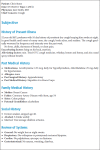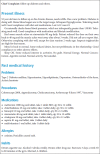Determining primary care physician information needs to inform ambulatory visit note display
- PMID: 24734131
- PMCID: PMC3974234
- DOI: 10.4338/ACI-2013-08-RA-0064
Determining primary care physician information needs to inform ambulatory visit note display
Erratum in
- Appl Clin Inform. 2014;5(1):190
Abstract
Background: With the increase in the adoption of electronic health records (EHR) across the US, primary care physicians are experiencing information overload. The purpose of this pilot study was to determine the information needs of primary care physicians (PCPs) as they review clinic visit notes to inform EHR display.
Method: Data collection was conducted with 15 primary care physicians during semi-structured interviews, including a third party observer to control bias. Physicians reviewed major sections of an artificial but typical acute and chronic care visit note to identify the note sections that were relevant to their information needs. Statistical methods used were McNemar-Mosteller's and Cochran Q.
Results: Physicians identified History of Present Illness (HPI), Assessment, and Plan (A&P) as the most important sections of a visit note. In contrast, they largely judged the Review of Systems (ROS) to be superfluous. There was also a statistical difference in physicians' highlighting among all seven major note sections in acute (p = 0.00) and chronic (p = 0.00) care visit notes.
Conclusion: A&P and HPI sections were most frequently identified as important which suggests that physicians may have to identify a few key sections out of a long, unnecessarily verbose visit note. ROS is viewed by doctors as mostly "not needed," but can have relevant information. The ROS can contain information needed for patient care when other sections of the Visit note, such as the HPI, lack the relevant information. Future studies should include producing a display that provides only relevant information to increase physician efficiency at the point of care. Also, research on moving A&P to the top of visit notes instead of having A&P at the bottom of the page is needed, since those are usually the first sections physicians refer to and reviewing from top to bottom may cause cognitive load.
Keywords: Attitude of Health Personnel; Data Display; Electronic Health Record; Information Needs; Information Seeking Behavior; Primary Care Physicians; User-Computer Interface.
Conflict of interest statement
The authors declare that they have no conflicts of interest in the research.
Figures












Similar articles
-
Electronic Health Records' Support for Primary Care Physicians' Situation Awareness: A Metanarrative Review.Hum Factors. 2023 Mar;65(2):237-259. doi: 10.1177/00187208211014300. Epub 2021 May 25. Hum Factors. 2023. PMID: 34033500 Free PMC article. Review.
-
Toward a patient-centered ambulatory after-visit summary: Identifying primary care patients' information needs.Inform Health Soc Care. 2018 Sep;43(3):248-263. doi: 10.1080/17538157.2017.1297305. Epub 2017 Apr 11. Inform Health Soc Care. 2018. PMID: 28398094
-
Dynamic Electronic Health Record Note Prototype: Seeing More by Showing Less.J Am Board Fam Med. 2017 Nov-Dec;30(6):691-700. doi: 10.3122/jabfm.2017.06.170028. J Am Board Fam Med. 2017. PMID: 29180544
-
Physician Information Needs and Electronic Health Records (EHRs): Time to Reengineer the Clinic Note.J Am Board Fam Med. 2015 May-Jun;28(3):316-23. doi: 10.3122/jabfm.2015.03.140244. J Am Board Fam Med. 2015. PMID: 25957364
-
Evidence Brief: The Quality of Care Provided by Advanced Practice Nurses [Internet].Washington (DC): Department of Veterans Affairs (US); 2014 Sep. Washington (DC): Department of Veterans Affairs (US); 2014 Sep. PMID: 27606392 Free Books & Documents. Review.
Cited by
-
Clinicians' reasoning as reflected in electronic clinical note-entry and reading/retrieval: a systematic review and qualitative synthesis.J Am Med Inform Assoc. 2019 Feb 1;26(2):172-184. doi: 10.1093/jamia/ocy155. J Am Med Inform Assoc. 2019. PMID: 30576561 Free PMC article.
-
Integrated displays to improve chronic disease management in ambulatory care: A SMART on FHIR application informed by mixed-methods user testing.J Am Med Inform Assoc. 2020 Aug 1;27(8):1225-1234. doi: 10.1093/jamia/ocaa099. J Am Med Inform Assoc. 2020. PMID: 32719880 Free PMC article.
-
Electronic Health Records' Support for Primary Care Physicians' Situation Awareness: A Metanarrative Review.Hum Factors. 2023 Mar;65(2):237-259. doi: 10.1177/00187208211014300. Epub 2021 May 25. Hum Factors. 2023. PMID: 34033500 Free PMC article. Review.
-
Variability in Electronic Health Record Usage and Perceptions among Specialty vs. Primary Care Physicians.AMIA Annu Symp Proc. 2015 Nov 5;2015:2053-62. eCollection 2015. AMIA Annu Symp Proc. 2015. PMID: 26958305 Free PMC article.
-
Foraging for Information in the EHR: The Search for Adherence Related Information by Mental Health Clinicians.AMIA Annu Symp Proc. 2017 Feb 10;2016:600-608. eCollection 2016. AMIA Annu Symp Proc. 2017. PMID: 28269856 Free PMC article.
References
-
- Bennett NL, Casebeer LL, Kristofco RE, Strasser SM.Physicians’ Internet information-seeking behaviors. The Journal of continuing education in the health professions 2004; 24(1): 31–38 - PubMed
-
- Fozi K, Teng CL, Krishnan R, Shajahan Y.A study of clinical questions in primary care. Medical Journal of Malaysia 2000; 55(4): 486–492 - PubMed
MeSH terms
LinkOut - more resources
Full Text Sources
Other Literature Sources

